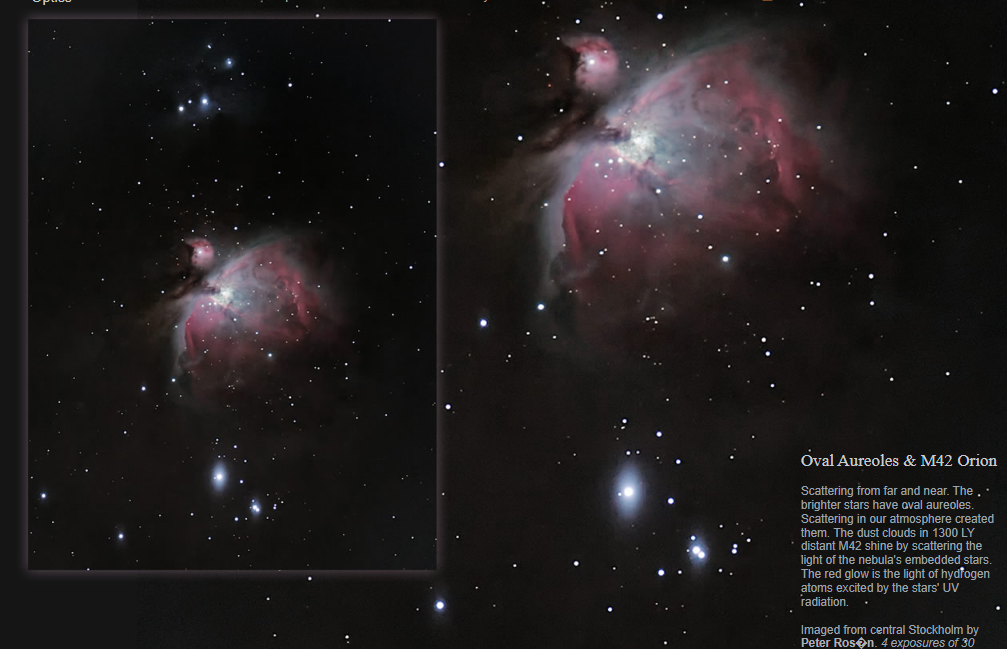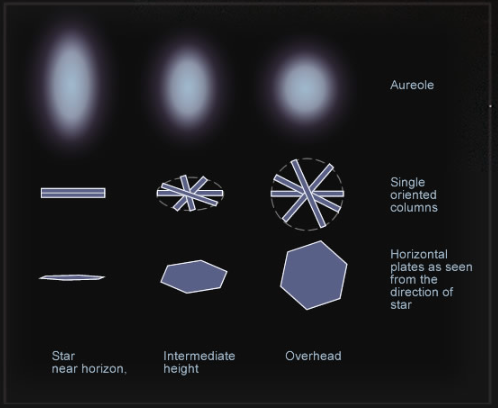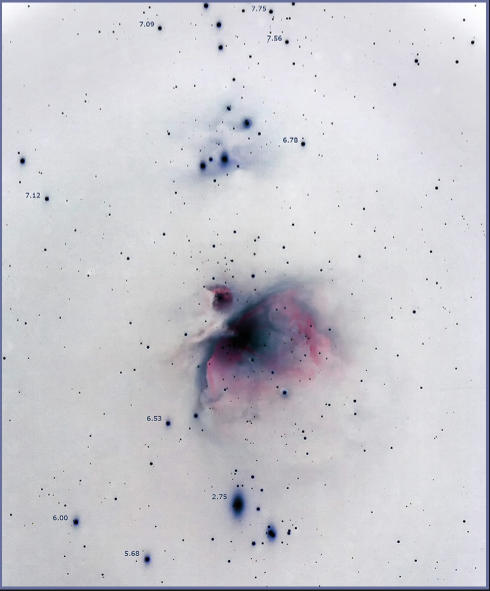OPOD -Orion Star Oval Aureoles
OPOD - Orion Star Oval Aureoles: Unveiling the Mysteries of Scattering and Diffraction
Have you ever gazed up at the night sky and noticed the peculiar oval-shaped halos surrounding certain stars? These enigmatic features, known as oval aureoles, have fascinated astronomers and sky enthusiasts for centuries. In this article, we will delve into the mesmerizing world of oval aureoles, with a particular focus on the captivating M42 Orion nebula. Prepare to embark on a journey of scientific discovery as we explore the mechanisms behind these celestial phenomena.
Scattering: The Creator of Oval Aureoles
Scattering, a phenomenon that occurs when light interacts with particles or molecules in the atmosphere, plays a crucial role in the formation of oval aureoles. As light from the stars within M42 Orion traverses our atmosphere, it encounters tiny dust particles suspended in the air. These particles scatter the light, causing it to deviate from its original path. The scattered light then reaches our eyes, giving rise to the stunning oval-shaped halos around the brighter stars.
The Luminous Dance of M42 Orion
Situated approximately 1,300 light-years away from Earth, the M42 Orion nebula captivates sky gazers with its ethereal beauty. Within this cosmic cloud of gas and dust, embedded stars emit ultraviolet (UV) radiation that excites hydrogen atoms, resulting in a mesmerizing red glow. When these stars' light interacts with the dust particles in our atmosphere, scattering occurs, giving birth to the oval aureoles that adorn the brighter stars within M42 Orion.
Decoding the Elongated Ovals
The elongated shape of these oval aureoles can be attributed to the diffraction of light by ice crystals present in our atmosphere. As these crystals descend through the air currents, they become aerodynamically oriented. When starlight from a relatively low star passes through these hexagonal ice crystals, the crystals appear horizontally elongated on average. This phenomenon leads to the vertical elongation of the resulting aureoles, creating the distinctive oval shape we observe.
Seeking Confirmation: The Quest for Simultaneous Images
To further validate the hypothesis regarding the formation of oval aureoles, astronomers and researchers eagerly seek near-simultaneous images of these celestial phenomena near the horizon and zenith. By comparing the characteristics of the aureoles in these different locations, scientists hope to gain deeper insights into the role of ice crystals and diffraction in shaping these captivating features.
The Mysterious Ovals Unveiled
A closer examination of the M42 Orion nebula reveals an intriguing celestial ensemble. At the heart of this cosmic masterpiece lies the brightest star in the field, iota Orionis, boasting a magnitude of 2.75. Positioned just below this stellar luminary, a pair of stars shines with magnitudes of 4.75 and 5.65. Even stars as faint as magnitude 7 exhibit these mesmerizing oval aureoles, as revealed in negative views captured by astrophotographers.
Unveiling the Wonders of the Night Sky
The study of oval aureoles not only provides us with a deeper understanding of atmospheric optics but also serves as a reminder of the profound beauty and complexity of our universe. These celestial phenomena, shaped by scattering and diffraction, add a touch of mystique to our nightscape, igniting our curiosity and inspiring awe. As we continue to explore the secrets of the cosmos, let us marvel at the wonders that await us, both within our atmosphere and beyond.

Oval Aureoles & M42 Orion
Scattering from far and near. The brighter stars have oval aureoles. Scattering in our atmosphere created them. The dust clouds in 1300 LY distant M42 shine by scattering the light of the nebula's embedded stars. The red glow is the light of hydrogen atoms excited by the stars' UV radiation.
Imaged from central Stockholm by Peter Ros�n. 4 exposures of 30 sec, 800 ISO, Canon EOS5D MkII through Williams Optics FLT 110 f/6.5 Apo refractor.
M42 was 25° high.
Images ©Peter Ros�n.

Diffraction by ice crystals in the air probably creates the elongated ovals.
The crystals are sufficiently large to be aerodynamically oriented as they drift downwards relative to local air currents. To starlight from a relatively low star the crystals - hexagonal plates or columns - appear on average to be horizontally elongated. The resulting scattering and diffraction creates a vertically elongated aureole.
We need near simultaneous images of star aureoles near the horizon and zenith to check this hypothesis!
Below:
The field's brightest star is mag 2.75 iota Orionis. To its lower right the star pair has magnitudes of 4.75 and 5.65. This negative view shows ovals on stars down to 7th magnitude.

Note: this article has been automatically converted from the old site and may not appear as intended. You can find the original article here.
Reference Atmospheric Optics
If you use any of the definitions, information, or data presented on Atmospheric Optics, please copy the link or reference below to properly credit us as the reference source. Thank you!
-
<a href="https://atoptics.co.uk/blog/opod-orion-star-oval-aureoles/">OPOD -Orion Star Oval Aureoles</a>
-
"OPOD -Orion Star Oval Aureoles". Atmospheric Optics. Accessed on April 24, 2024. https://atoptics.co.uk/blog/opod-orion-star-oval-aureoles/.
-
"OPOD -Orion Star Oval Aureoles". Atmospheric Optics, https://atoptics.co.uk/blog/opod-orion-star-oval-aureoles/. Accessed 24 April, 2024
-
OPOD -Orion Star Oval Aureoles. Atmospheric Optics. Retrieved from https://atoptics.co.uk/blog/opod-orion-star-oval-aureoles/.